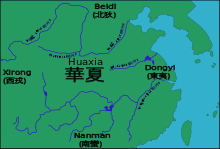Nanman
Nanman (simplified Chinese: 南蛮; traditional Chinese: 南蠻; pinyin: Nánmán; Wade–Giles: Nan-man; literally: "Southern Barbarians") was a historical pejorative term given by the Chinese to the indigenous inhabitants that lived in southwestern China. They are believed by scholars to be related to the Sanmiao, dated to around the 3rd century BC. The Nanman were multiple ethnic groups including the Zhuang, the Tai, and some non-Chinese Tibetan-speaking groups such as the Bai people and all Miao peoples. There was never a single polity that united these people.
The Book of Rites describes ancient stereotypes about the Si Yi "Four Barbarians" surrounding China.
The people of those five regions – the Middle states, and the [Rong], [Yi], (and other wild tribes round them) – had all their individual cultures, which they could not be made to alter. The tribes on the east were called [Yi]. They wore their hair long and natural, and tattooed their bodies with ink made from plants & roots. They were an agrarian people who lived off the land and raised their own animals for food. Those on the south were called [Man]. They also tattooed their foreheads with symbols, and were as tan-skinned as the Yi from working their crop fields and tending to animals. Those on the west were called [Rong]. They also wore their hair long and in braids. They sometimes sewed their animal skins into warm clothing. Some of them did not eat grain-food, however meat and fish were a main source of their diet. Those on the north were called [Di]. They also wove skins of animals and colorful birds to adorn their clothing, and preferred to build their shelters in the more mountainous hillsides. Some of them also did not eat grain-food, but relied heavily on a meat supply. The people of the Middle states, and of those [Yi], Man, [Rong], and [Di], all established their own individual cultures and thriving communities, where they lived at relative ease; with much peace among their tribes. They made clothes suitable for themselves; practical tools for proper use; and their shelters were diverse and prepared in abundance. In those five regions, the languages of the people were not mutually intelligible, as their likings and desires were different. To make what was in their minds apprehended, and to communicate their likings and desires, (there were officers) – in the east, called transmitters; in the south, representationists; in the west, [Di-dis]; and in the north, interpreters.[1]
Despite these various stereotypes and accounts recorded in the Book of Rites, little detail was known about their inner social hierarchies, their social customs, and the social interdependence among the tribes at that time. Modern day Miao or Hmong throughout the regions of China and southeast Asia have frequently been studied by scholars to reveal their ancient cultural traits, distinctive customs, and various languages that have survived throughout history.
During the Three Kingdoms period, the state of Shu Han ruled over Southwest China. After the death of Shu Han's founder, Liu Bei, the Nanman tribesmen of the region rebelled against Shu Han's rule. However, the Shu Han chancellor, Zhuge Liang, led a successful expedition to quell the rebellion. The Three Kingdoms period is one of the bloodiest in Chinese history.[9] In fact, it is considered the second deadliest period of warfare in history behind World War II.[9][10][11][12] A nationwide census taken in AD 280, following the reunification of the Three Kingdoms under the Jin shows a total of 2,459,840 households and 16,163,863 individuals which was only a fraction of the 10,677,960 households, and 56,486,856 individuals reported during the Han era.[13] While the census may not have been accurate due to a multitude of factors of the times, the Jin in AD 280 did make an attempt to account for all individuals including those whom they identified as the Nanman or Miao tribes where they could.
By the Tang dynasty, most of the Hmong were exterminated or assimilated into Chinese civilization except for those rebellious tribes in Yunnan, where they were ruled by the six Zhao (趙). The southernmost, known as Mengshezhao (Chinese: 蒙舍詔) or Kingdom of Nanzhao (Chinese: 南詔), united the six Zhao and founded the first documented independent Nanman state during the early 8th century. The tribe placed into royalty were thought to be Bai people. Nanzhao regularly paid tributes through the head of military district Jiannan Jiedushi (劍南節度使). When the Tang dynasty gradually declined, Nanman gained more independence, but were largely assimilated by later dynasties, in particular from the Mongols, in the Yuan Dynasty onward. However, some of Nanzhao's survivors carried on their cultural influences and were carried south into modern day Laos, Thailand, Vietnam, and Burma.
The early Chinese exonym Man (蠻) "southern barbarians" was a graphic pejorative written with Radical 142 虫, the "insect" or "reptile" radical. Xu Shen's (c. 121 CE) Shuowen Jiezi dictionary defines man as "Southern barbarians [who are an] elusive and shrewd race. [The character is formed] from [the] insect / serpent [radical and takes its pronunciation from] luàn 南蠻蛇種从虫䜌聲."[2]
References
- ↑ Wangzhi chap., tr. James Legge (1879), The Li Ki, Clarendon Press, vol.1, pp. 229-230.
- ↑ Tr. by Mair, Victor H. (2010), How to Forget Your Mother Tongue and Remember Your National Language, Pinyin.info.
